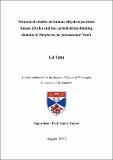Structural studies on human dihydroxyacetone kinase (DAK) and the carbohydrate-binding domain of Streptococcus pneumoniae NanA
Abstract
A number of dihydroxyacetone kinases (DAK) have been described that can utilize
either ATP (in animals, plants and some bacteria) or phosphoenolpyruvate (PEP) (in
most bacteria) as the energy source to convert dihydroxyacetone (Dha) to
dihydroxyacetone phosphate (DhaP), which plays critical roles in many metabolic
pathways. It has also been described that Homo sapiens DAK is able to regulate the
innate immune system via its interaction with Melanoma differentiation-associated
protein 5 (MDA5), which is recognized as an RNA sensor during virus infection.
These findings make H. sapiens DAK a very noteworthy research target due to its
multiple functions in many fields. Therefore, structural studies of DAK from H.
sapiens are presented.
The initial structure of the wild type (WT) H. sapiens DAK was determined to 2.5Å
resolution and solved by molecular replacement. The structure forms a homodimer
and four dimers were shown to be present in each asymmetric unit. However, within
each monomer, most regions of the C-terminal domain were disordered, and therefore
in order to improve structure quality, multiple site-directed mutagenesis was used. The
mutated protein was then crystallized and the structure was determined to 1.4Å. The
N-terminal Dha binding domain consists of two α/β regions and the C-terminal ATP
binding domain is comprised of eight anti-parallel α-helices, which forms a deep
pocket and is filled with a phospholipid molecule. In addition, the structures of
mutated DAK in complex with ATP analogues and Dha are also described in the
current study.
The second part of the project concerned sialidases, which are glycoside hydrolases that specifically hydrolyse terminal sialic acid from various glycans. Streptococcus
pneumoniae is one of the most common pathogenic bacteria of humans, and is
reported to encode three sialidases that act as virulence factors in bacterial
colonization and infection. One of these sialidases, NanA, was reported to be present
in all clinical strains and plays a vital role during the bacterial infection.
Consequently, the structure of N-terminal Carbohydrate-binding module (CBM)
domain of NanA has been determined to 1.8Å, and reveals a β-sandwich fold. The apo
form of NanA-CBM is present as a dimer in the asymmetric unit, whereas a monomer
was detected when it is bound to sialic acid or its derivatives. Structural comparisons
between NanA-CBM and other structures of the CBM40 family were also performed.
The substrate binding sites of NanA-CBM forms a cavity that is able to accommodate
the substrates. A potential molecular binding site located beside the sialic acid binding
site was revealed, and is occupied by the side chain of a lysine from a symmetry-
related molecule. Heteronuclear single quantum coherence (HSQC) NMR
spectroscopy and fluorescent-based thermal shift assays were also carried out to
further characterise the protein.
The current results reveal the structure of both DAK from H. sapiens and NanA-CBM
from S. pneumoniae, which may contribute to a better understanding towards cell
metabolism and bacterial colonization.
Type
Thesis, PhD Doctor of Philosophy
Items in the St Andrews Research Repository are protected by copyright, with all rights reserved, unless otherwise indicated.

